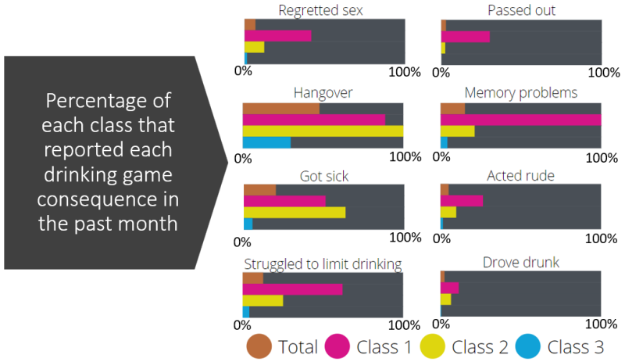The DRAM, Vol. 18(3) – I’m in that class too: A latent class analysis of college students’ drinking game consequences
The harmful public health impacts of college drinking have been well documented. Drinking games, which can increase the risk of drinking-related harms through rapid consumption of alcohol, are popular on college campuses. It is important for us to better understand the relationship between drinking games and drinking-related consequences so we can better tailor public health messaging to meet student’s needs. This week, The DRAM reviews a study by Dennis Hoyer and Christopher Correia that examined whether distinct groups of drinkers could be identified based on the consequences of their participation in drinking games.
What was the research question?
Can different groups of drinkers be identified by their drinking game consequences?
What did the researchers do?
The researchers recruited 656 college students who had consumed alcohol while playing drinking games in the past month and administered a survey assessing past-month drinking game motives, behaviors, and consequences (e.g., “engaged in unplanned sexual activity that I later regretted”; “had a hangover”; “got physically sick”); hazardous alcohol use; impulsivity; drinking motives; and daily drinking behavior. Then, the researchers created groups based on the types of drinking game consequences participants endorsed. They then compared these groups to see if they differed on any other variables such as daily drinking or drinking game motives.
What did they find?
Latent class analysis identified three distinct classes of drinking game players.
- Class 3 (73.2%) reported few past-month drinking game consequences aside from having a hangover the next day.
- Members of Class 2 (18.8%) were similar to members of Class 3, except that everyone in Class 2 reported having had a next-day hangover, and they were more likely to report having gotten sick while drinking.
- Finally, Class 1 (8.1%) reported the most severe consequences from drinking. This group had a moderate risk of becoming sick, tended to struggle to control their drinking, and had high rates of hangovers and blackouts. All other alcohol-related harms were also elevated in Class 1 compared to Classes 2 and 3 (see Figure).
Multiple variables were associated with class membership. For example, drinking for social enhancement or thrills was associated with membership in Classes 1 or 2, versus Class 3. Class 1 was also the most likely to report drinking to cope.

Figure. Prevalence of different drinking game consequences between classes and for the total sample. Click image to enlarge.
Why do these findings matter?
These findings show that while the majority of individuals who play drinking games only suffer a hangover the next day, a minority tend to face severe consequences from their drinking. Knowing this will help improve programs such as injunctive norm interventions by informing clinicians how often these consequences occur–information that therapists can pass on to clients who might be overestimating how common these consequences are.
Every study has limitations. What are the limitations in this study?
Most (95%) of the participants in this study were white and 75% were female, which may limit generalizability to the general population as both gender and ethnicity have been shown to be important factors in predicting alcohol use. Additionally, the study was limited to college students at a single university.
For more information:
University students worried about their drinking can typically find support on campus, and the NIAAA College Alcohol Policies Directory may be helpful in identifying these support resources. Individuals who may be worried their drinking is harmful can learn more at the National Institute on Alcohol Abuse and Alcoholism. Additional resources can be found at the BASIS Addiction Resources page.
— John Slabczynski
What do you think? Please use the comment link below to provide feedback on this article.